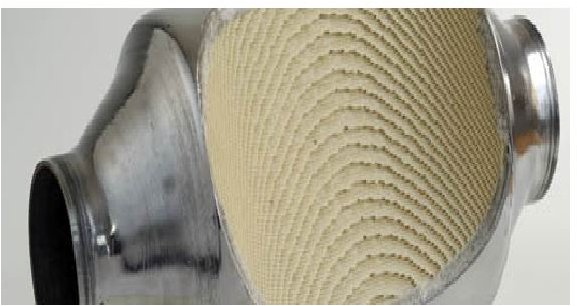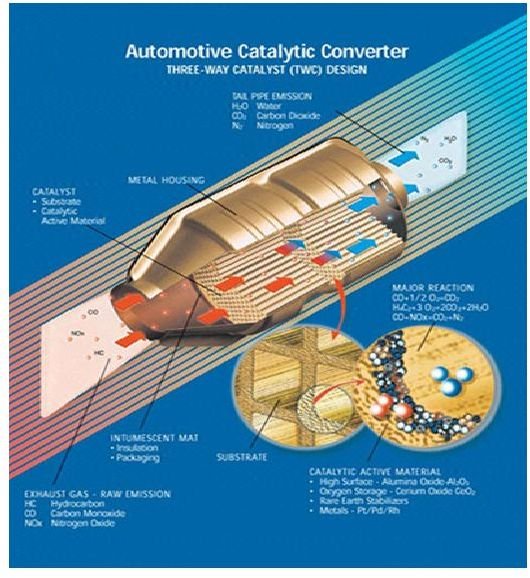Answers to, How Are Catalytic Converters Recycled
Introduction to Catalytic Converters
Catalytic converters are fitted to automobiles, trucks, vans, SUVs, trains and buses.
They are incorporated in the vehicle exhaust system near the engine, and are similar in shape to the normal muffler. They are used to convert the noxious exhaust gases resulting from petrol and diesel combustion into less polluting emissions.
When an automobile is scrapped and recycled, the catalytic converters are removed from the exhaust system and sent to a noble metal recycling facility.
This is an article on catalytic converters where we will investigate what happens to catalytic converters when a car is scrapped.
We begin with an overview of the purposes of the expensive metals used in the catalyst converters.
Overview of the Three-way Catalytic Converter
This is called a three way converter because of the three exhaust gases it controls:
- Carbon Monoxide and VOCs (unburned gases)
Palladium and Platinum convert these to carbon dioxide and water.
- Nitrogen Oxide
Palladium and Rhodium convert this smog producing gas to nitrogen and oxygen.
Recycling of Catalytic Converters
As we have seen when an automobile is recycled, the catalytic converter is removed before the car is crushed and shredded.
The catalytic converters are cut from the exhaust system and sent to a specialist recycling plant.
Here, the outer stainless steel container is split to remove the honeycombed interior which has had several layers of aluminum wash-coats applied. This is to ensure optimum spread of the Palladium, Rhodium and Platinum which are impregnated into the wash-coat, and act as catalysts. It is important not only to remove the honeycomb interior but any remaining particles and dust which will have accumulated in the catalytic converter container.
Once there is sufficient materials accumulated the next stage of recycling can commence.
This entails the crushing of the honeycomb into small pieces that are then fed through grinding or hammer mills to produce a fine powder.
The powder is now fed into a vessel containing a solution such as sodium hydroxide (a caustic soda) and this dissolves the aluminum wash-coat fragments, leaving a solution of the three catalysts.
There are several processes that can be applied from this stage to separate the catalysts;
- Drying of the powder then separation of the metals by screening and filtration.
- Further chemical treatment.
- Electrolysis (see my article on copper refining)
There is currently an innovative catalytic converter recycling process being researched and developed by the Japanese. Here, the whole catalytic converter unit is subjected to rapid heating in an electric arc furnace (see my article on recycling steel) then quenching in cold water. This separates the catalysts from the honeycomb, thus eliminating the need for immersion into caustic soda.
Application of Recycled Platinum, Palladium and Rhodium
New Catalytic Converters
Once the Palladium, Platinum and Rhodium have been extracted and separated from each other, they are almost exclusively reused in the manufacture of three-way catalytic converters for new vehicles.
Electronics
Recycled Platinum can also be used in the electrical circuitry of TVs, computers, iPods and mobile phones.
Note
Platinum is becoming a very scarce metal worldwide and this has resulted in it becoming more expensive than gold. This has prompted some automobile manufacturers into investigating the use of gold in the catalytic converter instead of Platinum.
Summary
Catalytic converters are part of a vehicle’s exhaust system, much like a normal muffler but located close to the engine, its purpose being to convert noxious gases into less harmful emissions.
So what happens to catalytic converters when the vehicle is scrapped and recycled?
Because of the expensive metals incorporated in the catalysis converter they are now being recycled to extract the Platinum, Palladium and Rhodium.
The recycling of catalytic converters is carried out at a specialist facility and the resultant reclaimed metals being reused in the manufacture of new catalytic converters.
Images


Internet Sites Visited
https://www.autocatalyst-recycling.umicore.com/process/https://www.environmental-expert.com/companies.aspx?word=catalytic%20converter